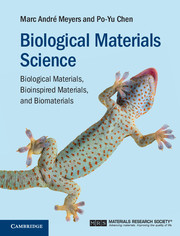Book contents
- Frontmatter
- Epigraph
- Contents
- Preface
- List of Boxes
- 1 Evolution of materials science and engineering: from natural to bioinspired materials
- Part I Basic biology principles
- Part II Biological materials
- Part III Bioinspired materials and biomimetics
- 12 Bioinspired materials: traditional biomimetics
- 13 Molecular-based biomimetics
- References
- Index
12 - Bioinspired materials: traditional biomimetics
from Part III - Bioinspired materials and biomimetics
Published online by Cambridge University Press: 05 August 2014
- Frontmatter
- Epigraph
- Contents
- Preface
- List of Boxes
- 1 Evolution of materials science and engineering: from natural to bioinspired materials
- Part I Basic biology principles
- Part II Biological materials
- Part III Bioinspired materials and biomimetics
- 12 Bioinspired materials: traditional biomimetics
- 13 Molecular-based biomimetics
- References
- Index
Summary
Introduction
It is a misunderstanding to think that the ultimate goal of biomimetics is to reproduce living organisms. There are essential differences, as we list in the following.
(a) Organisms are composed of cells (in the case of humans, 1013 of them). They direct a great deal of the activity. As seen in Chapter 4, each mammalian cell contains 10 000 different proteins, for a total of 500 million. There are numerous types of cells in each organism, and they have complex lives.
(b) Organisms are, for the most part, composed of a limited number of elements: C, Ca, H, O, P, N, and S. Synthetic materials have, on the other hand, a cornucopia of elements, made possible by the synthesis and processing techniques developed by humans.
What we try to do is to emulate the design and assembly principles used in natural materials. In this book we have seen many examples where superior properties are obtained through a hierarchical design and ingenious solutions. Bone, nacre, and dentin have toughnesses significantly superior to those of the mineral constituents, hydroxyapatite and calcium carbonate. Silk reaches strengths higher than 1 GPa using the weak hydrogen bond, through the existence of nano-scale β-sheet crystals with proper dimensions. Bioinspiration requires identification, understanding, and quantification of natural design principles and their replication in synthetic materials, taking into account the intrinsic properties (Studart, 2012). This approach is being pursued not only for structural materials, but also for functional materials and devices. The areas of sensing, optics, architecture, and robotics are exploring biological solutions.
- Type
- Chapter
- Information
- Biological Materials ScienceBiological Materials, Bioinspired Materials, and Biomaterials, pp. 499 - 559Publisher: Cambridge University PressPrint publication year: 2014



